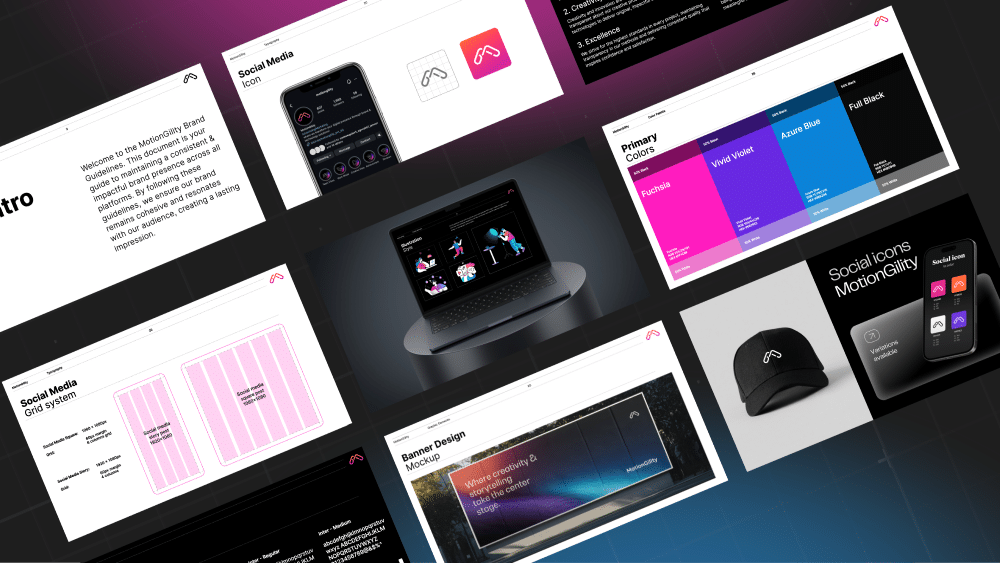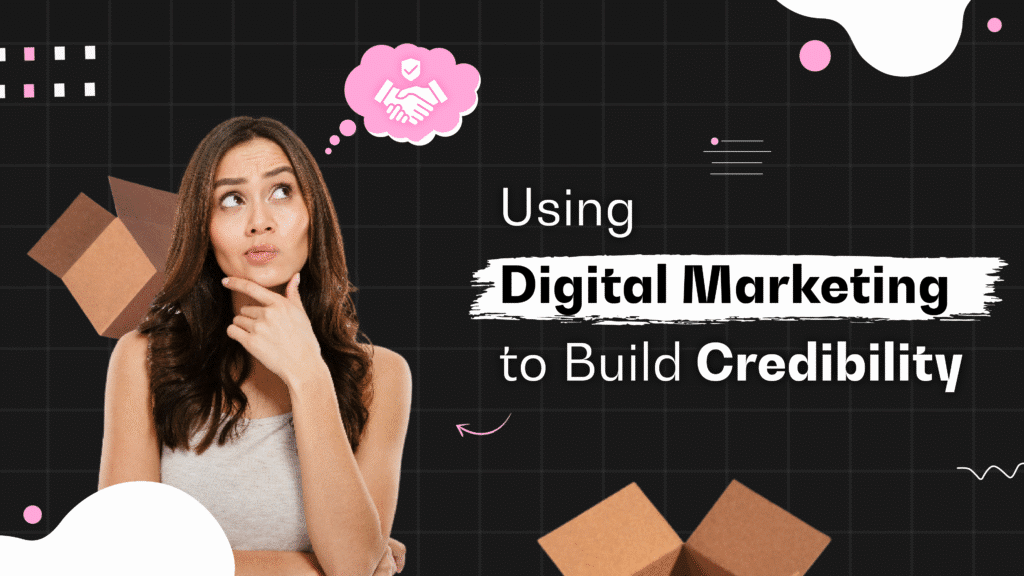It happens sometimes that we’re scrolling through our social media feed and instantly recognize a brand’s post, without even seeing their logo.
That’s branding at work, and those companies know how to build a strong brand identity.
Even 73% of consumers are more likely to buy from brands they recognize.
A strong brand identity is not just about pretty visuals or catchy taglines; it’s about creating a consistent and memorable experience that makes your audience stop and recognize you instantly.
But, how do you achieve that level?
In today’s article, we’ll walk you through the complete process of building a brand identity that not only looks great but also drives real business results.
Foundations of a Strong Brand Identity
Now, what is brand identity?
Well, it is the collection of all visual, verbal, and experiential elements that differentiate your business from competitors and make you recognizable in the market.
Just as you dress differently for a job interview versus a casual dinner, your brand identity should be created to achieve specific business goals.
But we’re living in a world where attention spans are shorter than ever. It takes just 7 seconds for someone to form an opinion about your brand.
So, your brand identity is often the first chance to make an impression.
Just give it a thought: when you see the distinctive red of Coca-Cola or Apple’s clean and minimalist design, you immediately know what to expect.

A strong brand identity does three crucial things for your business:
Differentiation: It helps you stand out in a crowded marketplace. When all your competitors look the same, a distinctive brand identity becomes your uniqueness.
Connection: It creates an emotional bond with your audience because people don’t just buy products, they buy into your story and experiences with you.
Trust: When your brand identity is consistent across all touchpoints, customers know what to expect from you.
Core Components to Build a Strong Brand Identity
Building a strong brand identity requires understanding its key components and how they work together to create a cohesive experience for your user.
Your brand identity includes:
1. Visual Elements
Your logo, color palette, typography, imagery style, and overall design aesthetic are the visual cues that make your brand instantly recognizable.
2. Verbal Elements
Your brand voice, messaging, taglines, and the way you communicate. This is how your brand “sounds” to your audience.
3. Brand Personality
The human characteristics your brand shows. Are you friendly and approachable? Professional and authoritative? Playful and creative?
4. Brand Positioning
Where you sit in the market and how you differentiate yourself from competitors. This is your unique value proposition in action.
Build a Strong Brand Identity With a Step-by-Step Guide
Building a brand identity that helps you drive desired business results requires a systematic approach. Here’s how to do it right:
Step 1: Research & Discovery
You can’t build a strong brand identity without knowing who you’re building it for.
So, start by getting clarity on your target audience. Go and create detailed buyer personas, and not just demographics. But dig deep into their emotions, too, like:
What are their desires? What problems and frustrations do they have? What brands do they already love?
Next, conduct a detailed audit of your current state of branding. If you’re starting from scratch, that’s fine, as you’ll be working with a blank canvas.
But if you’re rebranding, honestly evaluate what’s working and what isn’t in your current brand identity.
Then, don’t forget to research your competitors. You can go deep by asking questions like:
What colors dominate your industry? What messaging approaches are everyone using?
It’s not about copying others, but by doing this, you’re finding opportunities to differentiate your brand.
Step 2: Define Your Brand Strategy
Your brand strategy is the foundation for everything else related to your branding.
So, start by clarifying your brand’s core purpose. Like the reason your company exists beyond making money, and how your business and operations make a difference in the world?
Then, you need to define your brand positioning by figuring out the factors that make you different and what you can do better than anyone else.
This will become your competitive advantage and guide all your brand identity decisions.
Plus, your brand values should reflect what you stand for.
And do remember, these values aren’t just some feel-good statements; they should be principles that guide how you operate and what you prioritize.
Because 65% of consumers feel emotionally connected to a brand when it aligns with their values.
Step 3: Develop Your Brand Personality & Voice
For building a brand personality, you can think of your brand as a person and research how it would introduce itself.
Also, your brand personality should align with your audience’s preferences and, most importantly, your business goals.
Next, your brand voice or tone is how that personality translates in communication.
Are you conversational or formal? Witty or serious? You should decide this first and then document specific guidelines for your tone, vocabulary, and messaging style.
Then comes the time to craft your brand story, which is not just what you do, but why you do it.
It’s human behaviour that we connect with stories, not some features.
And to replicate that, ensure your audience is the hero of the story, with your brand as the guide helping them overcome challenges.
Step 4: Design Your Visual Identity
Now, you’ll be bringing your brand to life visually, so make sure your identity reflects your brand personality and appeals to your target audience.
You’ll be able to do that once you’ve understood the following elements of visual identity:
Color Psychology
You should choose colors that evoke the right emotions.
For example,
- Blue: trust and stability
- Red: energy and passion
- Green: growth and nature
Your color palette should include a primary color, 2-3 supporting colors, and accent colors for highlights.
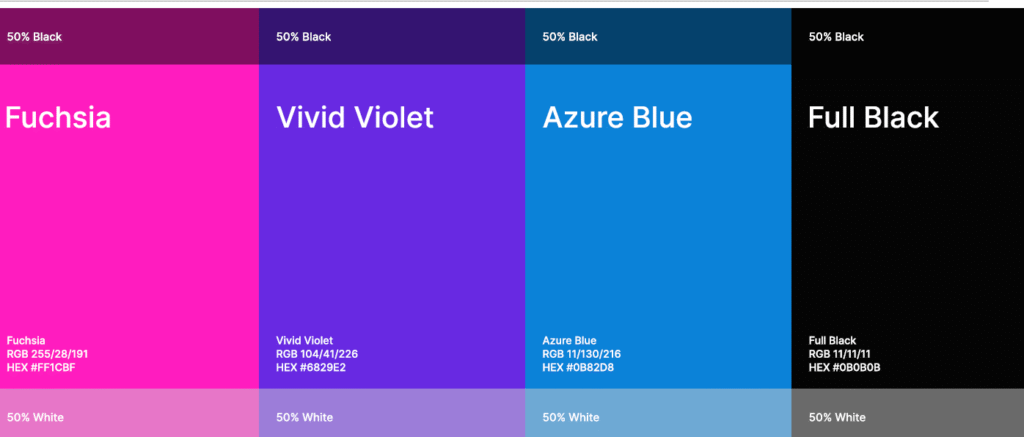
Typography
Select fonts that complement your brand personality.
A tech startup might choose clean, modern sans-serif fonts, while a luxury brand might go with elegant serif typefaces. While selecting fonts, you should limit yourself to 2-3 font families maximum.
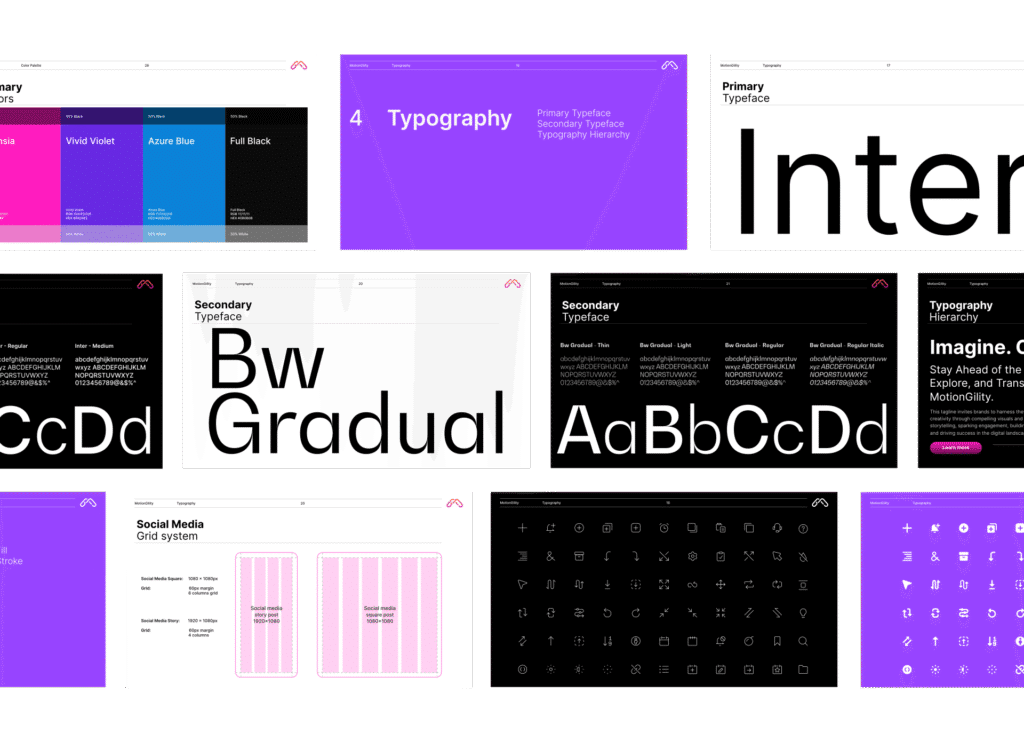
Logo Design
Your logo is one of the most important parts of your visual identity.
It should be simple to work at any size, memorable to stick in your users and customers’ minds, and flexible enough to work across different applications.
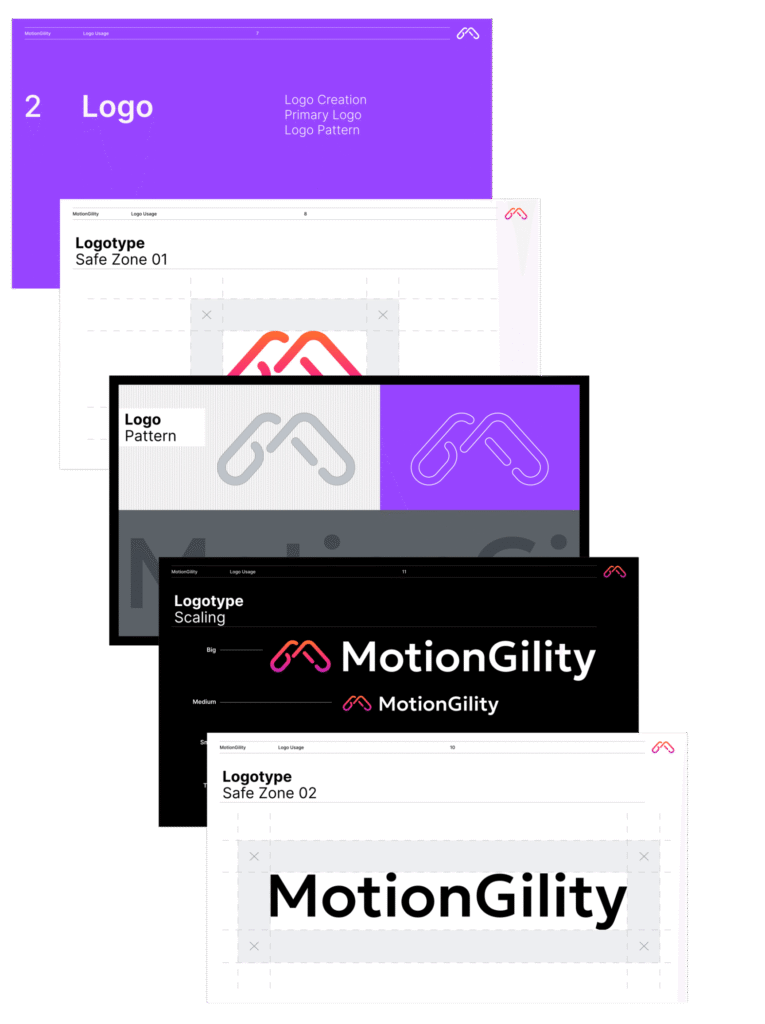
Supporting Elements
You can consider using additional visual elements like icons, illustration styles, photography guidelines, and graphic patterns to reinforce your brand identity.
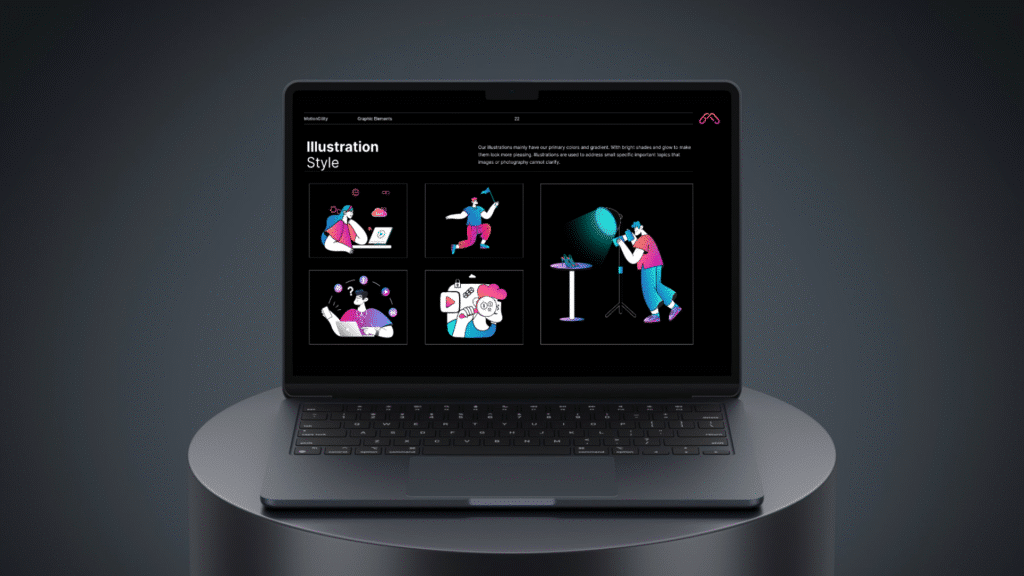
Step 5: Create Comprehensive Brand Guidelines
This is where many brands make the mistake, as they can design the most beautiful brand identity in the world, but if it’s not used consistently, it becomes useless.
Your brand guidelines should be a practical reference document that anyone on your team can follow.
If you want to see a real-life example, you can check our MotionGility’s brand guideline for a better understanding.
You must ensure to include clear rules for logo usage, color specifications, typography guidelines, imagery styles, and voice examples.
The brand guidelines should be comprehensive enough to maintain brand consistency but practical enough that your team will use them.
How to Integrate Your Brand Identity Across Your Business
A strong brand identity isn’t just for marketing; it should pass through your entire organization.
Here’s how you can ensure brand consistency across all your touchpoints:
1. Digital Presence
Your website, social media profiles, email signatures, and digital advertising should all reflect your brand identity. Every digital touchpoint should feel like it’s coming from the same brand.
2. Marketing Materials
From business cards to presentations, every piece should strengthen your brand identity. You can create templates to make it easy for your team to create brand-aligned materials.
3. Internal Culture
Your employees are your biggest brand ambassadors. So, make sure they understand your brand values because when your team genuinely believes in your brand, it shows in every customer interaction.
Common Brand Identity Mistakes To Avoid
If you can learn from common pitfalls, it can save you time, money, and potential brand damage.
Here, we’ve listed some brand identity mistakes:
1. Inconsistency
By using different colors, fonts, or messaging across platforms, you’ll confuse your audience and weaken brand recognition.
2. Chasing Trends Blindly
It’s important, as always, to stay current, but chasing every design trend can make your brand feel dated quickly. So, stick with evergreen elements that reflect your brand personality.
3. Ignoring Your Audience
If you’re creating a brand identity that’s appealing to you but not to your target market, it will definitely fail your efforts. That’s why keeping your audience at the center of your decisions is crucial.
4. Skipping the Process
Building a strong brand identity takes time, so never skip the research and strategy phases as they’re the foundation of everything else.
How to Measure Brand Identity Success
Is there any way to know if your brand identity is working? Well, yes, you can track the following key metrics by asking yourself some questions:
1. Brand Awareness
Are more people recognizing your brand? To answer it, you can survey your audience or track branded search volume.
2. Brand Perception
What do people think about your brand? For this, you can monitor social media sentiment and customer feedback.
3. Customer Loyalty
Are your customers spending more time on your website or social media? To know this metric, you can track retention rates and repeat purchases.
4. Premium Pricing
Can you charge more because of your brand equity? Strong brands can often demand higher prices for their services/products.
Conclusion
Building a strong brand identity isn’t a one-time project, but an ongoing process because markets keep evolving and customer change their preferences with time.
That’s why it’s necessary to regularly audit your brand identity to ensure it still resonates with your audience and supports your business goals.
At MotionGility, we have successfully helped multiple companies improve and enhance their brand identity through our Branding Services
We understand that your brand identity is one of your most valuable business assets.
So, we do it in such a way that it drives customer loyalty and sets you apart from the competition.
If you want that for your business, you can contact us for our branding services.
Keep in mind that building a strong brand identity is an investment in your business’s future success.


